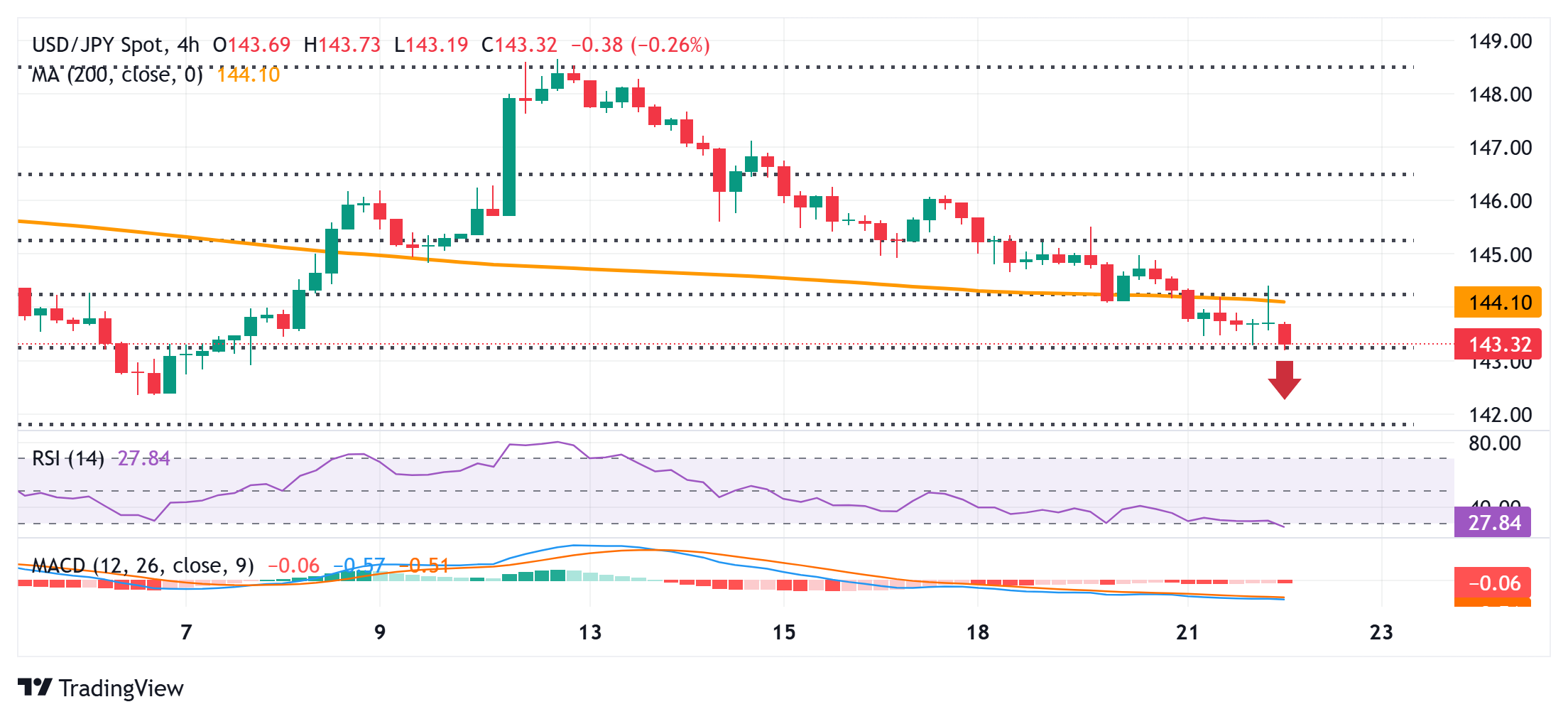- The Japanese Yen attracted some dip-buyers following upbeat domestic data.
- BoJ rate hike bets and reviving safe-haven demand also lend support to the JPY.
- The prevalent USD selling bias further exerts downward pressure on USD/JPY.
The Japanese Yen (JPY) retains its positive bias through the Asian session and trades near a two-week high touched against a broadly weaker US Dollar (USD) earlier this Thursday. Japan’s upbeat Machinery Orders data countered recession fears and boosted hopes for an economic recovery. This, along with the growing acceptance that the Bank of Japan (BoJ) will hike interest rates again in 2025, turns out to be a key factor that continues to act as a tailwind for the JPY.
Meanwhile, US President Donald Trump’s proposed sweeping tax bill fueled concerns about the US government’s fiscal health. Adding to this, renewed US-China tensions weigh on investors’ sentiment and further underpin the traditional safe-haven JPY. The USD, on the other hand, remains depressed amid worries about the deteriorating US fiscal outlook and bets for further rate cuts by the Federal Reserve (Fed). This further contributes to the USD/JPY pair’s decline.
Japanese Yen bulls retain control amid BoJ rate hike bets, weaker risk sentiment
- Data released earlier this Thursday showed that Japan’s Core Machinery Orders – a key leading indicator of capital spending over the next six to nine months – rose 13.0% in March, defying forecasts for a 1.6% decline. This marks the highest level in nearly two decades and assists the Japanese Yen to attract dip-buyers.
- The Bank of Japan recently showed a willingness to hike interest rates further this year amid signs of broadening inflation in Japan. Moreover, investors expect that rising wages could lead to a significant increase in consumption, which, in turn, should allow the central bank to continue on its path of policy normalization.
- Atsushi Mimura, Japan’s Vice Finance Minister for International Affairs and top foreign exchange official, said early Thursday the US did not discuss FX levels at the finance ministers’ meeting. Mimura does not believe that there is any gap in understanding with the US and reaffirmed that forex should be determined by the market.
- Investors remain hopeful about progress in trade negotiations between the US and Japan and the possibility of an eventual deal. Japan’s Trade Minister Ryosei Akazawa is expected to attend the upcoming third round of ministerial-level talks with US Trade Representative Jamieson Greer. Moreover, US Treasury Secretary Scott Bessent is also likely to take part in the trade negotiations.
- US President Donald Trump’s dubbed “One Big, Beautiful Bill” is expected to come to the House floor for a vote sometime on Thursday, and if passed, will add $3 trillion to $5 trillion to the federal deficit over the next ten years. This adds to worries about a deteriorating US fiscal outlook and weighs on investors’ sentiment.
- China accused the US of abusing export control measures and violating Geneva trade agreements after the US issued guidance warning companies not to use Huawei’s Ascend AI chips. China’s Commerce Ministry said on Wednesday that US measures on advanced chips are ‘typical of unilateral bullying and protectionism.’
- Federal Reserve officials expressed concerns over economic and business sentiment in the wake of the uncertainty tied to the Trump administration’s trade policies. Adding to this, a weak 20-year Treasury bond sale reinforced the view that investors are shying away from US assets and kept the US Dollar depressed.
- Trump reportedly told European leaders that Russian President Vladimir Putin isn’t ready to end the war with Ukraine, as he thinks he is winning. Meanwhile, Israel’s military continued to pound the Gaza Strip and block desperately needed food aid. This keeps geopolitical risks in play and further benefits the safe-haven JPY.
- Thursday’s release of flash PMIs could provide a fresh insight into the global economic health. Moreover, trade developments should influence the broader risk sentiment. Adding to this, the US macro data – the usual Weekly Initial Jobless Claims and Existing Home Sales – might provide some impetus to the USD/JPY pair.
USD/JPY consolidates near 61.8% Fibo. retracement level before the next leg down

From a technical perspective, the USD/JPY pair’s intraday move up on Thursday falters near the 144.40 region. The said area nears a confluence support breakpoint – comprising the 50% retracement level of the April-May rally and the 200-period Simple Moving Average (SMA) on the 4-hour chart – and should act as a key pivotal point. A sustained strength beyond could trigger a short-covering move, though it is likely to attract fresh sellers near the 145.00 psychological mark. This should cap spot prices near the 145.35-145.40 region, or the 38.2% Fibo. retracement level, which, if cleared decisively, might shift the near-term bias in favor of bullish traders.
Meanwhile, oscillators on the daily chart have just started gaining negative traction and suggest that the path of least resistance for the USD/JPY pair remains to the downside. However, the Relative Strength Index (RSI) on the 4-hour chart has moved on the verge of breaking into oversold territory, making it prudent to wait for some near-term consolidation before positioning for the next leg of a downfall. That said, acceptance below the 143.20 area, or the 61.8% Fibo. retracement level, might prompt some technical selling and drag spot prices below the 143.00 round figure, to the next relevant support near the 142.40-142.35 area en route to the 142.00 mark.
Bank of Japan FAQs
The Bank of Japan (BoJ) is the Japanese central bank, which sets monetary policy in the country. Its mandate is to issue banknotes and carry out currency and monetary control to ensure price stability, which means an inflation target of around 2%.
The Bank of Japan embarked in an ultra-loose monetary policy in 2013 in order to stimulate the economy and fuel inflation amid a low-inflationary environment. The bank’s policy is based on Quantitative and Qualitative Easing (QQE), or printing notes to buy assets such as government or corporate bonds to provide liquidity. In 2016, the bank doubled down on its strategy and further loosened policy by first introducing negative interest rates and then directly controlling the yield of its 10-year government bonds. In March 2024, the BoJ lifted interest rates, effectively retreating from the ultra-loose monetary policy stance.
The Bank’s massive stimulus caused the Yen to depreciate against its main currency peers. This process exacerbated in 2022 and 2023 due to an increasing policy divergence between the Bank of Japan and other main central banks, which opted to increase interest rates sharply to fight decades-high levels of inflation. The BoJ’s policy led to a widening differential with other currencies, dragging down the value of the Yen. This trend partly reversed in 2024, when the BoJ decided to abandon its ultra-loose policy stance.
A weaker Yen and the spike in global energy prices led to an increase in Japanese inflation, which exceeded the BoJ’s 2% target. The prospect of rising salaries in the country – a key element fuelling inflation – also contributed to the move.

